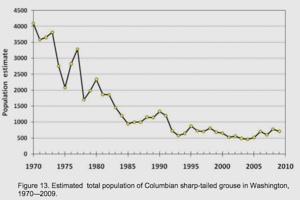

Home | Contact Us | About Us | Join CELP | Ralph W. Johnson

Center for
Environmental Law & Policy
Sharp-tail Grouse and Sustainable Land Use
Sharp-tail grouse require large amounts of intact (unfragmented) habitat. These birds also require healthy riparian habitat. In the winter, sharp-tail grouse survive by eating the buds from deciduous trees such as aspen, birch and chokecherry. Riparian habitat is at risk in Tunk Valley because of the imminent threat of additional exempt wells.
Tunk Valley is unique. The fact that Tunk Valley is one of the last places to support sharp-tail grouse results from a combination of historical circumstances. The road that runs through it, dead-ends on public lands. The valley is too dry for agriculture and too remote from town to attract residential land use -- until recently. Tunk Valley was one of the last places in the country to receive electricity. Until the 1990s the community still had “party lines”. This valley is also an important component to Wildlife Corridors that prevent genetic isolation of species.
Starting in the 1960s, the federal government recognized that open space was disappearing, and provided low interest loans to ranching “associations”. Open space in Tunk Valley was preserved in part by one of those Grazing Associations. Ranchers have not sold out. Consequently, Tunk Valley has the largest contiguous block of shrub steppe habitat in Okanogan County.
The forested hills circling the valley floor belonged to the local mill. Pressures to subdivide Tunk Valley for real estate development started when the mill went bankrupt. In around 1990 developers bought the land.
Thousands of acres have been sold, and therein is the risk to water supplies: exempt wells will rapidly exhaust the waters of Tunk Valley. Already withdrawals are exceeding the rate of precipitation, which is the sole source of water in the Valley. Tunk Creek is already over-appropriated.
Residential development is an incompatible land use to sharp-tail grouse and grazing. Grazing can be a compatible land use (J Connelly. Habitat Needs and Protection for Columbian Sharp-tailed Grouse in Washington with Emphasis on Okanogan County). The Valley can support as many as 1,100 pasture-fed cattle during the “grazing season”. A generous estimate of water consumption per animal per day would be 20 gallons. This would equal approximately 22,000 gallons per day, or about the equivalent of four 5,000 gallon exempt wells.
County officials are planning to zone the Tunk Valley for new development rather than designating it “Agricultural Land of Long Term Commercial Significance”, as required by the GMA. For Tunk Valley, subdivisions (and the resulting loss of stream flows and groundwater) will devastate the sharp-tailed grouse and a way of life for local ranchers.
References
-
-Draft Washington State Recovery Plan for the Columbian Sharp-tailed Grouse. Washington Dept of Fish & Wildlife.
-
-GMA and Local Wetland Regulations. Washington Dept of Ecology.
-
-Critical Areas and Best Available Science (BAS). Washington Dept of Commerce.



